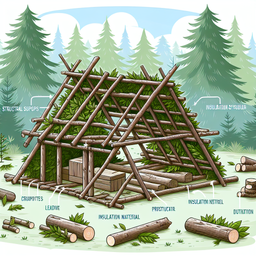Shelter
Immediate Shelter
In the short-term, seek out sturdy existing structures if available, such as:
- Abandoned buildings
- Caves
- Dense foliage or tree cover
If no structures exist, create a basic lean-to shelter:
- Find a long, sturdy branch or fallen tree to serve as the main beam
- Prop one end up on a tree or rock about waist high
- Lay smaller branches or sticks close together on one side of the main beam to create a wall
- Cover the wall with leaves, grass, pine needles, or other vegetation for insulation
- Lay more branches, leaves and soft vegetation inside the shelter for bedding

Longer-Term Shelter
As soon as possible, begin constructing a more permanent shelter:
- Use sturdy materials available in the environment, such as:
- Clay, adobe bricks, or wattle and daub in grasslands and near rivers
- Stone in rocky areas
- Wood and logs in forests
- Build on high ground to avoid flooding
- Include a heat source like a fire pit with a chimney to vent smoke
- Create raised sleeping platforms to stay dry
- Construct a sloped roof to shed rain, with an overhang to keep walls dry
- Allow ventilation and some natural light
- Include cross-ventilation with a small opening near the floor on one wall, and a larger opening up high on the opposite wall for air flow
- Include a smoke hole in the roof to vent smoke and allow light
- Build near clean water and other key resources, but avoid natural hazards like cliffs, flood zones, and insect breeding areas
- Orient the shelter to maximize natural heating from the sun in cold climates, or to align with prevailing winds for cooling in hot climates
Back to Table of Contents
